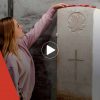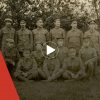Activity
Tools and suggestions for planning an in-person or virtual Remembrance Day ceremony for a class, school or other group
Planning a Remembrance Day Ceremony
You can use the resources from this web module to create a Remembrance Day ceremony.
When planning the ceremony, start from the most important element — the two minutes of silence, observed at 11 a.m. – and build out from there. Select other elements from among the resources and suggestions listed below. Consider also whether you have access to any special contributors in your school or community that could be incorporated into the ceremony, such as a choir or drama group who could perform, or a veteran or current serving military member who could speak.
Building Blocks for a Remembrance Day Ceremony
Two Minutes of Silence
Length: 2 minutes
The two minutes of silence should be observed on 11 November at 11 a.m. Before the minutes begin, provide students with context by explaining the historical significance and directing their thoughts as follows:
The First World War ended on 11 November 1918 at 11 a.m. Today, we honour the country’s sacrifice in all wars and conflicts with two minutes of silence at that time. Use this time to think about the contributions of the men and women who have served in the Canadian military, the sacrifices made in war and how we might strive for a more peaceful world. Please stand for two minutes of silence.
Music
Length: varies
The minutes of silence are often immediately followed by the national anthem (“O Canada”) or a solemn piece of music (for example, “The Last Post”). The Legion website offers links to songs for use in the ceremony: https://www.legion.ca/remembrance/remembrance-day/ceremony-music
Wreath Laying
Length: 5-10 minutes
Wreath laying is a traditional part of a Remembrance Day ceremony. During a school-wide assembly, representatives from each class bring a wreath to the front of the room and lay them at the foot of a designated area. This is sometimes done by students who are cadets or members of similar organizations. The wreaths may be made by students (for example, decorated with poppies made by the students) or purchased from the Legion.
Media Presentation
Length: 3-5 minutes per selection
Select from among the media presentations in the Canadian War Museum Remembrance web module’s Every Object Tells a Story series to share stories of wartime service and sacrifice. You can use one or several, and show them in a block, or intersperse them throughout the ceremony.
Reading
Length: 1- 3 minutes per selection
The poem “In Flanders Fields” is traditionally read at Remembrance Day ceremonies.
- “In Flanders Fields”: Canada’s most famous war poem, written in 1915 by Lieutenant-Colonel John McCrae. See the Appendix for the full text of the poem in English and French.
You may want to supplement the reading with other selections from the Remembrance Day resources. Suggested readings:
- Letter, 4 June 1944: Paratrooper Leslie Neufeld wrote this letter home before he was dropped into Normandy, France on D-Day (6 June 1944). It was his last letter home—he was one of the 359 Canadian army servicemen killed on D-Day.
- Letter, 19 February 1944: Peggy Rainville wrote this letter to her husband, Guy, while he was missing in action after his aircraft was shot down over Germany. She expresses the worry and uncertainty of military families.
- Diary, 13 April 2009: Martin Rouleau writes about the death of his roommate, Karine Blais, while serving in Afghanistan. He expresses the bonds between service personnel and feelings of survivor’s guilt.
Activity – Discussing Art and Photographs
Length: 10-20 minutes for one painting or photograph.
For a ceremony with a small group, rather than a school-wide ceremony, a discussion around an artwork or photograph can be a powerful way of introducing concepts of service, sacrifice and remembrance. Select one or two paintings or photographs from the Remembrance Day Module.
Suggested Ceremony Scenarios
Scenario 1: In the Classroom
Length: 30 minutes
| 10:40-10:55 | Activity – Discussing Art and Photographs facilitated discussion of the painting The Flag |
| 10:55-10:58 | Watch Every Object Tells a Story: Teddy |
| 10:58-11:01 | Introduce and stand for two minutes of silence |
| 11:01-11:03 | Sing “O Canada” |
| 11:03-11:05 | Read “In Flanders Fields” |
| 11:05-11:10 | Watch Every Object Tells a Story: Tombstone of the Unknown Soldier |
Scenario 2: School-wide Assembly (short)
Length: 30 minutes
| 10:45-10:48 | Welcome remarks (refer to Remembrance Backgrounder for the history of Remembrance Day) |
| 10:48-10:52 | Watch Every Object Tells a Story: Tombstone of the Unknown Soldier |
| 10:52-10:56 | Reading of “In Flanders Fields” and/or archival letter |
| 10:56-11:01 | Introduce and stand for two minutes of silence |
| 11:01-11:04 | Singing of “O Canada” |
| 11:04-11:08 | Watch Every Object Tells a Story (Artifact of your choice) |
| 11:08-11:10 | Closing remarks |
Scenario 3: School-wide Assembly (long)
Length: 45 minutes
| 10:45-10:50 | Welcome remarks (refer to Remembrance Backgrounder for History of Remembrance Day) |
| 10:50-10:54 | Watch Every Object Tells a Story: Tombstone of the Unknown Soldier |
| 10:54-10:59 | Reading of “In Flanders Fields” and/or archival letter |
| 10:59-11:01 | Introduce and stand for two minutes of silence |
| 11:01-11:04 | Singing of “O Canada” |
| 11:04-11:10 | Wreath Laying |
| 11:15-11:25 | Special presentation: choir, drama club or special guest |
| 11:25-11:29 | Watch Every Object Tells a Story (Artifact of your choice) |
| 11:29-11:30 | Closing Remarks |
Scenario 4: Virtual Ceremony
Length: 30 minutes
| 10:45-11:00 | Watch Every Object Tells a Story (all artifacts) |
| 11:00-11:01 | Observe two minutes of silence |
| 11:01-11:15 | Activity: How to Analyze a Primary Source or How to Analyze an Artifact |

 Video
Video
 Video
Video
 Video
Video
 Video
Video
 Video
Video